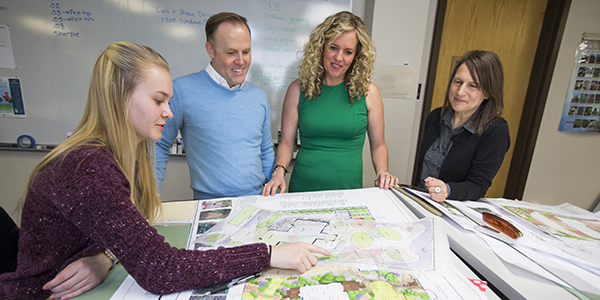
Learning from the ground up
Story by Barb McBreen
Image by Christopher Gannon
Sculpting landscape is an art that requires an understanding of lines, perspective, elevation, balance and color. The artist must incorporate soils, plants and structures.
Lisa Orgler, a senior lecturer in horticulture and Iowa State landscape architecture grad, helps students master that art by working through the process from concept to construction.
“The biggest thing I want them to learn is they are creating a space, not just placing plants in the ground,” Orgler says. “They are creating garden rooms.”
Each spring Orgler teaches a landscape design class in which students learn to create landscape drawings addressing various scenarios and incorporating different themes. When students finish their landscape drawing they share it with the class, similar to what a professional landscape designer would do with a client.
Learning design principles is what Brenna Rodenburg, a sophomore in horticulture, appreciates about Orgler’s class.
“It’s understanding unity, order and balance in a design. Anyone can plop plants somewhere they think look pretty, but understanding why they should go there and how they work together is the main thing that’s helping me become a better designer,” says Rodenburg.
When you walk into Orgler’s design class you can feel her connection to her students. The room is full of light chatter and laughter. Her enthusiasm is obvious.
Students, who were assigned the same project parameters, have designed everything from formal gardens, to wispy prairie retreats, to angular and practical landscaped yards. The designs, posted along one wall, look like pieces in an art gallery. After one presentation, Orgler provides feedback about the use of space. She points to an open courtyard in the design and comments on how the elements in a sitting area are too centered.
“This is typical when we have an open space. We want to center everything in the space, but you need to consider the spatial connection and relationship with other areas outside that space,” Orgler says.
After another student’s presentation, Orgler explains spatial design needs to be well thought-out. For the final assignment the class met with a client in Ames. The students visited the site, measured the area, developed maps and listened to the client’s vision for the yard. It’s an experience that replicates the service they’ll provide as professional landscape designers.
Iowa State alumni Dianne and Dave Brotherson, who live in Ames and work at Iowa State, said the class provided them with several designs three years ago. Dianne was impressed with the designs, but also the option to implement the design over several years.
“It turned out very nice,” Dianne says. “It was fun working with students and seeing their ideas. We even bought the plants for the prairie garden from the Iowa State Horticulture Club.”
Giving students an opportunity to work with clients gives them a real-world perspective. Orgler says she can give them feedback, but a client directs them according to their personal preferences, similar to what landscape professionals experience.
She also teaches a landscape class preparing students to compete in the annual National Collegiate Landscaping Competition. The 42-year-old competition was held in mid-March at Alamance Community College in Graham, North Carolina. The competition is another way to help students get hands-on experience.
The competition included close to 40 events ranging from plant identification to irrigation to business management. Brenna Rodenburg, a sophomore in horticulture and vice president of the Iowa State Landscape Club, says the workshops she attended provided information about industry trends.
“The first day we were there we attended several workshops and I went to a sustainability workshop,” Rodenburg says. “The one I liked the best was a green roof workshop. They explained how you can install them on your house.”
Diana Cochran, an assistant professor in horticulture and Horticulture Club adviser, accompanied the Landscape Club to the competition as a faculty adviser. She also remembers attending the competition as a student and says it completely changed the direction of her career.
“When I think about my career I can trace it back to this competition,” Cochran says. “That is where I found my first internship.”
She says that internship led to other opportunities, which introduced her to professors who convinced her to go to graduate school. More than 700 students attended the nationwide competition, which hosts one of the largest landscape design career fairs in the nation.
“I always encourage students to go because you meet people who are in your field and people who are passionate about the same things you are,” Cochran says.
The Landscape Club sent 15 students to the competition. The club raised funds for the trip by selling one-hour landscape consulting sessions. Orgler says she was on hand to help students during the consults.
“They were working with real clients and they did an amazing job,” Orgler says. The competition isn’t about winning, Cochran says, but describes it as a competition for all the right reasons. The Iowa State team placed in the top half overall. She says it helps students learn how to think on their feet and solve problems.



